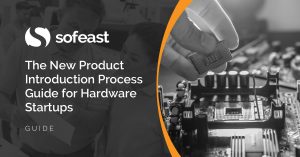When developing a new electro-mechanical product, there is a tradeoff:
- Do you want to spend less time & money before production (during the NPI process), and suffer higher costs for each unit made?
- Or do you want to invest more before production, and enjoy lower unit costs?
Here are some examples of where this tradeoff is evident.
Tooling
Nowhere is it more obvious than in tooling.
If projected quantities are high and if adding 30,000 or 50,000 USD in the process development is not an issue, then investing more in tooling makes sense.
More sophisticated tooling can help in many ways:
- Less secondary processes (no need to make adjustments to get to the desired visual aspect after the parts are fabricated)
- Faster manufacturing (several parts can be made in 1 shot if there are several cavities)
- Less assembly work, as the parts can already be more advanced/complex
Quality
It is obvious when it comes to quality, too.
If you can have a good process engineer and a good quality engineer spend a lot of time on your new product introduction project, there are many ways they can prevent quality issues and save you money. Here are a few examples:
- Conducting design- and process-related risk analyses all along the development, and spending time looking for ways to reduce risk.
- Pointing to potential human mistakes in the assembly process, and thinking of mistake-proofing countermeasures. This is best started early when reviewing the first drafts of the parts’ drawings.
- Setting up an automatic detection system on a key process, to reduce the need for visual inspection.
- Documenting it all in a process control plan, and auditing to that plan.
- Spending time at the key suppliers’ facilities, setting up a very clear acceptance standard for them, and ensuring they understand it fully.
Pilot runs
Where all this comes together is the pilot runs, to validate that all is ready before mass production.
For the same product, the results might be as follows:
- If little investment in NPI: first-time good quality (yield) of 75%, assembly time of 55 seconds per piece.
- If high investment in NPI: first-time good quality (yield) of 90%, assembly time of 30 seconds per piece.
And these differences will remain through mass production. The difference might be smaller, as the process gets mature and people work on optimizing it (switching to another component supplier, adding a few fixtures for assembly, improving a testing station, etc.). But it will definitely remain.
That’s why one of the first questions from potential suppliers is always “how many pieces are you planning to make?” It determines so many aspects of the project.
Want to learn more about the new product introduction process for hardware startups?
Are you currently starting the new product introduction process, or having some issues getting a product that is being produced in China to market? My company Sofeast’s guide covers everything hardware startups need to know for making a new product in China and successfully bringing it to market.
Hit the button below to read the guide:



